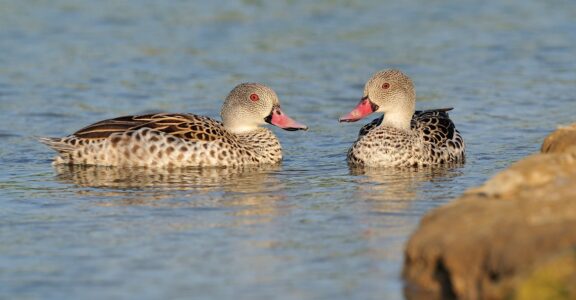Cape Teal

Scientific name
Anas capensis
Alternative names
Cape Wigeon, Cape Widgeon
Measurements
| Feature | Range / Note |
|---|---|
| Length | 44–46 cm |
| Weight | 316–502 g (11–18 oz) |
| Wingspan | Not specifically recorded |
Status
Not considered endangered. Classified as Least Concern, population is large and appears to be increasing.
Identification
Cape Teals are small, pale ducks with mostly grey mottled plumage, a browner back, pink bill, and reddish eyes. The speculum is green and black, bordered with white. Males and females look similar, though females are slightly smaller, paler, and less speckled. Juveniles lack the pink on the bill.
Behavior
They are mostly quiet; males emit a high-pitched whistle during displays, and females respond with a soft nasal quack. They are dabbling ducks but occasionally dive underwater. Cape Teals perform “nod swimming” courtship displays without actually nodding. Both parents help raise ducklings and defend them aggressively.
Distribution
Found across sub-Saharan Africa, including Angola, Botswana, Chad, Ethiopia, Kenya, Mozambique, Namibia, Niger, Nigeria, South Africa, Sudan, Tanzania, Zambia, and Zimbabwe.
Habitat
Occupies shallow saline lakes, seasonal and permanent brackish or saline pools, rivers, seasonally flooded wetlands, farm dams, reservoirs, coastal shorelines, estuaries, lagoons, tidal mudflats, and wastewater treatment pools.
Feeding
Omnivorous. Diet includes stems, leaves, seeds of pondweeds, aquatic insects, crustaceans, tadpoles, and small invertebrates obtained by dabbling.
Breeding
Nest is a hollow scrape on the ground, concealed among small trees, thorny bushes, or aquatic vegetation, often near water. Females lay 7–8 eggs, incubated for 25–26 days. Both parents rear the ducklings. Ducklings fledge in about 6 weeks. Sexual maturity is reached at 1–2 years.
Wintering
Non-migratory, but may move opportunistically with rainfall and flooding. Forms moulting flocks up to 2,000 birds.
Conservation
Population is large and stable, benefiting from dams, reservoirs, and irrigation projects. Potential threats include wetland destruction, altered flood regimes, habitat degradation, and disturbance from tourism. Species is also hunted for food by humans and predators.
